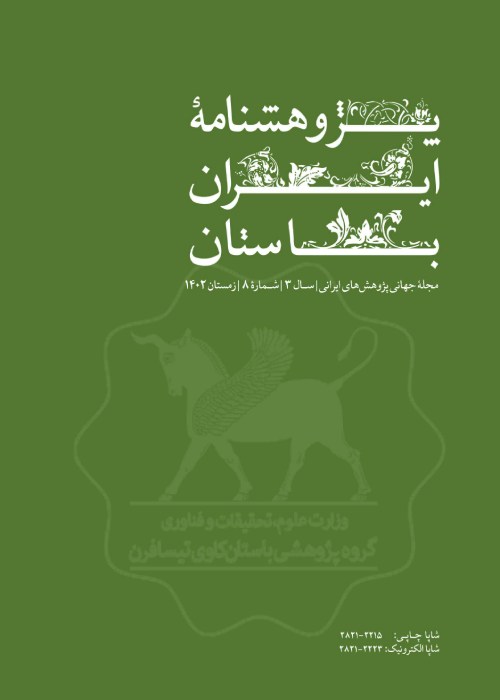فهرست مطالب
Journal of Ancient Iranian Studies
Volume:2 Issue: 6, Summer 2023
- تاریخ انتشار: 1402/04/01
- تعداد عناوین: 6
-
-
Pages 3-34The commercial and cultural relations of Shahr-i Sokhta with neighboring areas have a relatively long and complex history. During the first period of Shahr-i Sokhta, there are many evidences indicating the connection of this large center with the south of Mesopotamia, Elam and the southern parts of the Iranian plateau. There was also an extensive connection between this center and Central Asia, Afghanistan and the Waziristan region that overlooks the Indus valley. Based on archeological evidence, in parallel with the emergence of the social and economic structure and the beginning of urbanization, we see a significant expansion of trade with distant regions.Keywords: Sistan, cultural relations, Shahr-i Sokhta, Middle Asia
-
Pages 35-49In a survey carried out in the Sadrabad area of Zarandieh in June 2020, in addition to the whole village of Sadrabad, its satellite areas were also examined and identified, which led to remarkable results in the archaeological studies of the Iranian plateau, which in addition to other archaeological survey, metal slags were also studied and analyzed there. Slag is the residue of minerals from the smelting, which occurs naturally as a molten silicate or as a mixture of several silicate minerals with compounds of oxides, sulfides, and metals. To detect metal minerals in slag, it is necessary to prepare a polished section from the samples in order to identify its type . The silicate minerals in the slag are studied with passing light using a thin section. Gazanak Zarandieh Tepe is located 85 km from Tehran and 75 km from Saveh in Sadrabad Vilage in Zarandieh city of Markazi province. The oldest settlement phase identified in this area is Neolithic (or Pre-pottery Neolithic) and the newest period identified is related to the Safavid era. In this survey, we obtained evidence of smelting and processing of copper, which included pure native copper and slag from smelting of this metal, which by integrating them for laboratory studies, especially the petrographic elemental analysis, which resulted in amazing results. The purpose of petrographic testing on study samples is to identify the components of the slag, the type of material extracted and, if possible, the host rock mineral. Since the study area lacks Chalcolithic age, and the abundance of plum ware, which appeared in the context of Cheshmeh Ali pottery and the transition period according to the speculation of the 2021 season, led us to the question that melting and extraction copper metal in the center of the Iranian plateau has an older history than the dates presented in this article.Keywords: Petrography, Slag, Gazanak, copper
-
Pages 51-56Epic heroes are noble individual of prodigious martial strength but they too mostly pass through several trials to prove their legitimate position. These endeavors include battles with evils while the heroes rarely overcome mental evils. The trials are challenging for heroes’ power to defeat the evil. The seven trials of Rostam and Isfandiyār as well as the twelve trials of Heracles fall in this category. Twelve thousand years of the Zoroastrian world includes an eternal battle between good and evil and the good will win this battle at last in the Armageddon. Zoroaster is the highest level of Ahura Mazda’s forces against Angra Mainyu. He too passed the seven trials in his childhood and adulthood which is not though the pure history but mixed with the myths and epics. Therefore, he acts as a hero to prove his legitimacy and triumph over dēws, Karaps and evil thoughts was his utmost aim and established Zoroastrianism through converting Goštāsp and his court. All of the trials he passed proved his legitimacy for being the prophet.Keywords: epic, hero, Seven Trials, Zoroaster
-
Pages 57-75An archaeological survey was conducted in 2004-2005 in the middle of Mianab Shushtar in Khuzestan, followed by an excavation there in 2005-2006, which led to the discovery of a Sasanian palace as well as valuable stuccoes at two other locations, namely the JilJilak Tepe and behind a Gas Station on the Shushtar-Ahwaz Road. In this article, the discovered stuccoes have been examined, which indicates that the Jiljilak stuccoes can be divided into three categories based on their features and application: a) geometric patterns, b) plant patterns, and c) animal patterns. Comparing these stuccoes with those found elsewhere such as Kuh-e Khwaja, Bīshāpūr, and Bandian in Dargaz shows that they can be attributed to the Parthian-Sasanian period.Keywords: Stuccoes, Dastowā, JilJilak, Parthian, Sasanian
-
Pages 77-83The current study tries to discuss a Golden Bowl with four-headed lion which is kept at the Mostazafan Foundation’s Cultural Institution of Museum. In addition to minor cracks and fractures at several places on the body, the cylindrical rim of the bowl has also been slightly altered and deviated from its original form, making it difficult to distinguish the lower part of it and the base. As can be seen, its bottom design is adorned with five circles, with one being a water lily with twelve petals. In this article, the author studies this bowl and based on iconography, argues that this was related to the Achaemenid period.Keywords: Achaemenid, Golden Bowl, Four-headed Lion, Cultural Institution of Museum
-
Pages 85-89
For years, various researchers, including theologians, cultural anthropologists, linguists, and archaeologists, have been studying the Zoroastrian religion. These studies provide valuable insights into this religion and those who believe in it. However, there are still researchers who are trying to shed light on the sometimes-unclear aspects of this religion. In the past, researchers focused solely on historical and religious texts to express their views on this subject. Today, archaeological excavations and previous researches assist in shedding new light on this religion. One of the most important books in this regard that uses historical and religious texts and archaeological findings is Zoroastrianism: An Introduction by Jenny Rose. This book was published in 2011 by I. B. Tauris Publisher.
Keywords: Zoroastrianism, religion, Historical Records, Archeological Excavations


